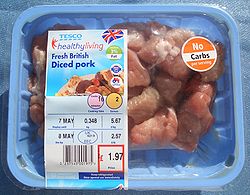Food packaging
Food packaging is packaging for food. It requires protection, tampering resistance, and special physical, chemical, or biological needs. It also shows the product that is labeled to show any nutrition information on the food being consumed.

Packaging has several objectives:[1] Physical protection - The food enclosed in the package may require protection from, among other things, shock, vibration, compression, temperature, etc. Barrier protection - A barrier from oxygen, water vapor, dust, etc., is often required. Permeation is a critical factor in design. Some packages contain desiccants or Oxygen absorbers to help extend shelf life. Modified atmospheres or controlled atmospheres are also maintained in some food packages. Keeping the contents clean, fresh, and safe for the intended shelf life is a primary function. Containment or agglomeration - Small items are typically grouped together in one package for reasons of efficiency. powders, and granular materials need containment. Information transmission - Packages and labels communicate how to use, transport, recycle, or dispose of the package or product. Some types of information are required by governments. Marketing - The packaging and labels can be used by marketers to encourage potential buyers to purchase the product. Package design has been an important and constantly evolving phenomenon for several decades. Marketing communications and graphic design are applied to the surface of the package and (in many cases) the point of sale display. Security - Packaging can play an important role in reducing the security risks of shipment. Packages can be made with improved tamper resistance to deter tampering and also can have tamper-evident features to help indicate tampering. Packages can be engineered to help reduce the risks of package pilferage: Some package constructions are more resistant to pilferage and some have pilfer indicating seals. Packages may include authentication seals to help indicate that the package and contents are not counterfeit. Packages also can include anti-theft devices, such as dye-packs, RFID tags, or electronic article surveillance tags, that can be activated or detected by devices at exit points and require specialized tools to deactivate. Using packaging in this way is a means of retail loss prevention. Convenience - Packages can have features which add convenience in distribution, handling, stacking, display, sale, opening, reclosing, use, and reuse. Portion control - Single serving packaging has a precise amount of contents to control usage. Bulk commodities (such as salt) can be divided into packages that are a more suitable size for individual households. It also aids the control of inventory: selling sealed one-liter-bottles of milk, rather than having people bring their own bottles to fill themselves. Drink boxes, an example of aseptic processing The above materials are fashioned into different types of food packages